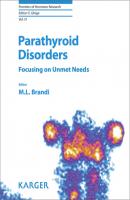Parathyroid Disorders. Группа авторов
Чтение книги онлайн.

Читать онлайн книгу Parathyroid Disorders - Группа авторов страница 8
Название: Parathyroid Disorders
Автор: Группа авторов
Издательство: Ingram
Жанр: Биология
Серия: Frontiers of Hormone Research
isbn: 9783318064094
isbn:
Diagnosis and Clinical Features
Asymptomatic PHPT is caused by inappropriate secretion or oversecretion of parathyroid hormone (PTH) [10]. Solitary parathyroid adenomas cause PHPT 80–85% of the time, whereas multigland hyperplasia is found in 15–20% of cases, and parathyroid cancer is noted in less than 0.5% of cases [11]. As with other endocrine tumors, pathologic diagnosis of parathyroid carcinoma is difficult and is usually based on the examination of local tissue, presence of vascular invasion, or detection of metastatic disease [12]. Most single adenomas are due to sporadic disease, whereas 4-gland hyperplasia implies a familial disorder, most commonly MEN1 or 2A, or familial isolated PHPT [13].
The causes of asymptomatic sporadic PHPT are not well understood. It is presumed that causes of asymptomatic PHPT are similar to those causing symptomatic PHPT. Previous exposure to neck irradiation contributes in a minority of cases, typically 20–30 years after such exposure [14]. More commonly, adenomas represent clonal expansion of a single or several abnormal cells, attributable to a genetic abnormality that results in either stimulation of cell proliferation or loss of inhibition of cell proliferation [15].
Normocalcemic, or “incipient,” hyperparathyroidism occurs when serum calcium is normal but PTH is increased, without evidence of vitamin D deficiency, hypercalciuria, or other causes of hyperparathyroidism [16]. This condition requires documentation of normal serum 25-hydroxyvitamin D and 24-h urine calcium levels to rule out other causes of physiological hyperparathyroidism. It may be due to an early stage of evolving PHPT or very mild PHPT, with more complications than expected for asymptomatic PHPT [17].
Most current patients with PHPT in Europe and the USA are asymptomatic, typically with serum calcium levels <1.0 mg/dL above the upper end of the normal range [18]. Most of these cases lack classical skeletal features, including osteitis fibrosa cystica or osteoporosis. Bone disease is currently diagnosed in <5% of patients with PHPT [19, 20]. Bone density of the 1/3 distal radius increases the detection rate of osteoporosis in patients with PHPT by 11% [21]. Renal disease, including nephrocalcinosis, calcium-containing nephrolithiasis, or renal insufficiency, may be found in up to 20% of patients [22]. Hypercalciuria is reported in up to 30% of patients [23].
Asymptomatic patients do not complain of mild fatigue, weakness, or subtle cognitive impairment [24]. Other classical abnormalities of PHPT, such as gout or pseudogout, anemia, band keratopathy, or loosened teeth due to lamina densa resorption, are rarely seen in patients with asymptomatic PHPT.
Laboratory Findings
Patients with asymptomatic PHPT typically have laboratory values similar to, but somewhat milder, than those with symptomatic PHPT. Serum total and ionized calcium may be high-normal or mildly increased [25]. The serum phosphate level is usually low-normal or mildly decreased, in conjunction with normal serum creatinine. Intact PTH, measured by the second generation 2-site immunoradiometric assay or immunochemiluminometric assays, or the newer third generation intact assay, is mildly increased or inappropriately high-normal for the level of serum calcium [25]. Serum 1,25-dihydroxyvitamin D levels may be high-normal or mildly increased, with serum 25-hydroxyvitamin D levels usually low-normal. In up to 30% of patients, 24-h urinary calcium excretion may be increased.
Imaging
Some patients with asymptomatic PHPT have positive imaging with a parathyroid sestamibi scan, but because they do not meet other criteria for surgery, surgery is delayed. However, some asymptomatic patients will eventually become symptomatic or meet the criteria for surgery. Most centers prefer to use 99mTc-sestamibi scanning first to localize parathyroid adenomas, but there is variability, and some prefer to use ultrasound, 4D-CT scans, or MRI as the imaging method of choice.
In a small series, Cheng et al. [26] assessed whether a positive 99mTc-sestamibi scan could predict future surgical eligibility in patients with asymptomatic PHPT. In a retrospective study of 94 asymptomatic patients who had PHPT and underwent a 99mTc-sestamibi scan with SPECT/CT imaging, 35 patients had scan results and follow-up for at least 1 year. Of these 35 patients, 12 had positive scans and 23 had negative scans at baseline, and did not meet criteria for surgery at the time of imaging. At a median follow-up of 2.4 years (range 1–4 years), 6 of 12 patients with a positive scan at baseline became eligible for surgery later, whereas 20 of 23 patients with negative scans remained asymptomatic and did not meet the criteria for surgery. The authors concluded that a positive parathyroid 99mTc-sestamibi scan with SPECT/CT imaging predicted a higher possibility of meeting the surgical criteria later in patients with asymptomatic PHPT who do not meet criteria for surgery when they initially present.
Natural History
Sun et al. [27] reviewed the experience with PHPT at a single regional hospital in China between 2005 and 2016, and reported that 73.1% of the 260 patients documented remained symptomatic, but that 27.9% were asymptomatic. The number of patients with symptomatic PHPT increased by 2.5-fold from 2005 to 2016, whereas the number of patients with asymptomatic PHPT increased by up to 3-fold over the same interval.
Therapeutic Management
Surgical Treatment
Surgical decisions about patients with asymptomatic PHPT depend on the presence of hypercalcemia or complications. Approximately 100,000 new cases of PHPT are diagnosed each year in the USA. Most of these patients are asymptomatic and have a relatively mild form of the disease, and present with few if any obvious signs or symptoms. Recent consensus indicates that asymptomatic patients with PHPT may have improved outcomes after curative surgery [28].
Table 1. Guidelines for surgery in asymptomatic PHPT: a comparison of current and previous recommendations
Four СКАЧАТЬ